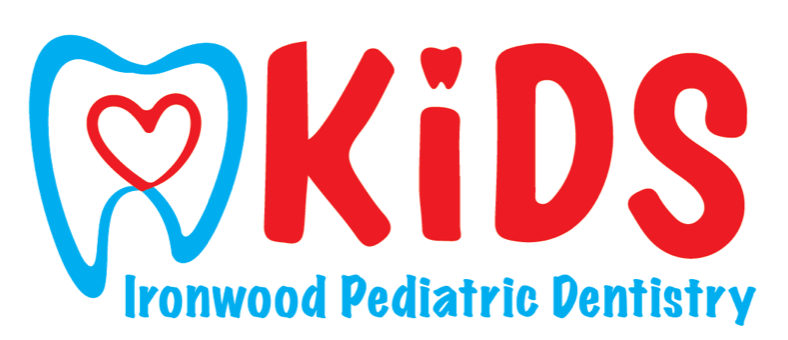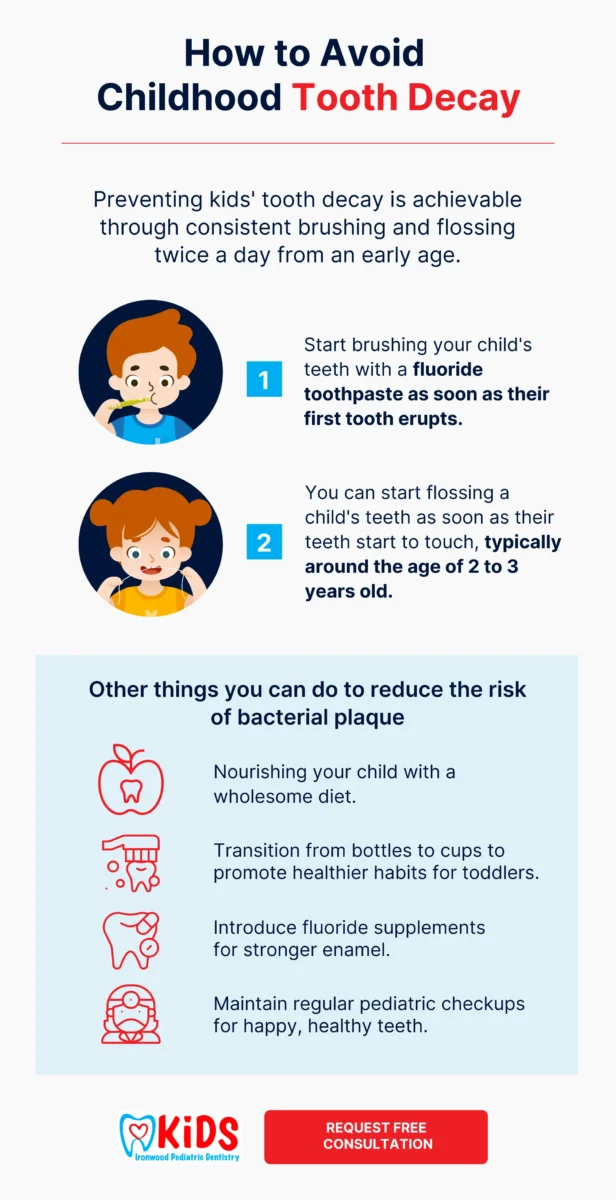Early Childhood Tooth Decay
Home Pediatric Dentistry Early Childhood Tooth Decay
Tooth decay in children is a common problem in Arizona and the United States in general. Consider the following statistics:
- Almost one-quarter of children ages 2 to 5 years have had tooth decay in their primary teeth. One in ten children ages 2 to 5 years has untreated tooth decay.
- A little more than half of children ages 6 to 8 years have had tooth decay in their primary teeth. One of every six children ages 6 to 8 years has untreated tooth decay.
But is there any dependable tooth decay treatment near me, you may be thinking? Fortunately, children’s tooth decay is preventable through brushing, flossing, and regular check-ups with your child dentists at Ironwood Dental in Scottsdale, Arizona. We can also fix problems with tooth decay for your child after the prevention window closes.
Learn more below about what childhood tooth decay is and how it starts, what later child tooth decay stages look like, as well as how you can help your child to avoid tooth decay and how we treat it in our pediatric dental offices.
Causes of Childhood Tooth Decay
Tooth decay is the result of acid corrosion of the tooth enamel. This corrosion leads to pitting in the enamel—the earliest form of “caries,” the dental term for a tooth cavity. If the corrosion goes on untreated, eventually it will penetrate through the tooth enamel to the point where it will reach the inner, sensitive part of the tooth. This is when your child will begin to experience that sudden and intense tooth pain when eating or drinking, the sharpness of which anyone who has ever had an unfilled cavity remembers all too well.
The source of this corrosive acid are harmful bacteria that live in your child’s mouth. These bacteria feed on tiny bits of food left over after eating or drinking. They feed on any food source, but they are especially fond of carbohydrates, most notably sugar.
The acidic waste product the bacteria leave behind is a filmy residue that is plaque.
It only takes a few hours for plaque to begin to form on your child’s teeth. Not only is plaque the source of the tooth enamel corrosion, but if it is left undisturbed by a toothbrush for more than a few hours, that plaque will also begin to transform into tartar, a hardened form of plaque that forms along the gumline.
Tartar is the source of gum diseases including gingivitis and periodontitis, that if left untreated can eventually cause serious harm to the tooth below the gumline, including cavities. Ultimately, untreated periodontitis can lead to the need for dental surgery, like a root canal, or result in the need to extract the tooth.
Contributing Factors to Children’s Tooth Decay
Plaque formation is a natural process. But there are things that you and your child might be doing that could accelerate its formation without you knowing it. Here are some common contributors to accelerated childhood tooth decay that we see in our Scottsdale, Arizona offices:
- Feeding children foods that are rich in sugar, like fruit juices.
- Allowing children to go to bed without brushing their teeth.
- Putting infants to bed with a bottle of milk, formula, or juice.
In addition, some contributors to childhood tooth decay may be out of your control. For example, whether your tap water supply is fluoridated, or certain physical conditions like dry mouth from a lack of saliva production.

Symptoms of Childhood Tooth Decay
The earlier you can detect the signs of child tooth decay, the sooner you can get your child to our offices so we can treat it before it becomes a more serious problem. Here are some visual indicators of early child tooth decay:
- White spots on the teeth (bad white, not teeth-whitening white). Also known as “chalky teeth,” these spots are the earliest sign you will see that tooth enamel is beginning to break down from bacterial acid corrosion.
- A brown-colored spot on a tooth is the first indication that a cavity has formed. The darker the shade of brown, eventually turning to black, the deeper the cavity.
Once a cavity has penetrated far enough into the tooth enamel, then beyond what you might see—remember, cavities can form in places that are hard for you to look at, like in the back of the mouth in between teeth—your child will eventually begin to experience tooth pain.
How to Avoid Childhood Tooth Decay
As you can see, childhood tooth decay is both an immediate problem and a source of potential long-term trouble. That is the bad news.
The good news is, children’s tooth decay is almost entirely preventable. All it takes is applying some healthy teeth cleaning habits as early as possible in childhood, in particular making sure to brush and floss at least twice a day:
- The time to start brushing your child’s teeth with a fluoride toothpaste is as soon as the first baby tooth erupts.
- You can start flossing your child’s teeth beginning at two years of age.
Other things you can do to reduce the risk of bacterial plaque taking hold in your child’s mouth center on minimizing sugar in the diet and avoiding behaviors that contribute to plaque and tartar build-up in between teeth brushings:
- Feed your child a healthy diet. Avoid or limit foods and drinks that are laden with sugar, like candy, soft drinks, and starchy, carbohydrate-rich foods like potato chips or other snack foods.
- Stop bottle feeding your child as soon as reasonably possible. Avoid letting your child keep a bottle handy with milk or juice in it as a pacifier. If you put your infant to bed with a bottle, fill it with water instead of milk or juice. Begin teaching him or her to start drinking from a cup around age six months, and to stop using a bottle entirely around one year of age.
- If your tap water is not fluoridated, consider a fluoride supplement. Most tap water supplies in Arizona are fluoridated. If yours is not, though, then adding a fluoride supplement in addition to fluoride toothpaste can be helpful in strengthening your child’s tooth enamel to better resist cavities.
- Take your child to us for regular checkups. Starting when the first baby teeth emerge, around age two, we recommend your child visit the dentist for a dental check-up every six months. This way, we can catch tooth decay in your child’s teeth even when you can’t see it, and treat it in time before it becomes a serious oral health problem.
Treatment Options for Childhood Tooth Decay
If your child is experiencing tooth decay, then our treatment will depend on factors like how old your child is, the severity of the cavity, gum disease, or both, and other health-related conditions that may be specific to him or her.
To treat cavities, we use dental fillings. This involves removing any decayed enamel, then filling in the gap with a filling material. At Ironwood Dental, we use tooth-colored fillings made of modern resin materials instead of the old, metal-based, “silver fillings” of yesteryear. These fillings are durable, affordable, and possibly most importantly from your child’s point of view, nearly invisible.
Dental fillings are one-day appointments in our Scottsdale, AZ office.
For more serious child tooth decay problems, then depending on the extent of the tooth damage we can apply more intensive treatments like crowns, inlays, veneers, or if necessary, tooth extractions and bridges.
These treatments may in some cases require two office visits to complete. As with dental fillings, the materials we use in these more involved treatments are colored to match the surrounding teeth.
Call Us Today to Protect Your Child from Tooth Decay
The most important thing to remember about preventing cavities through tooth decay self-care is that, with a little consistent effort on your part and later on that of your child, you can largely take control over whether your child will experience problems with cavities or gum disease.
Developing the habit of regular brushing and flossing is the most important thing you can do for your children’s oral health—and in some ways their overall health—today, tomorrow, and for the rest of their lives. We cannot emphasize this too forcefully.
If you need support in teaching your child good oral hygiene habits, we can help you.
The second most important thing you can do is to set up a twice-yearly dental checkup schedule with us for your children. This way, we can spot problems you might not see early, so we can treat it in the simplest and most affordable way possible. Remember, finding cavities in your child’s mouth can be like discovering roaches in your home: by the time you see the first one, chances are good there are others you have not seen yet. We can find them all during a regular checkup appointment, and make sure none of them become serious.
Is your child currently experiencing mouth pain? Then call us now at (480) 422-4544 to schedule an appointment so we can treat it.
Are you wondering, “Where can I find child tooth decay treatment near me? Is there even a tooth decay dentist near me?” Then call Ironwood Pediatric Dentistry at the number above, or if you prefer, you can ask us online and we will get back to you.
Childhood tooth decay and cavities will not correct themselves once they get started. If you think your child might be suffering from a cavity, then delaying treatment will only make things worse. Call our dental team at Ironwood Dental now at (480) 422-4544 and let one of our children’s tooth decay treatment Scottsdale experts help take the pain away and keep it away.


